Bharat Petroleum Bundle
How Does Bharat Petroleum Company Thrive in India's Energy Landscape?
Bharat Petroleum Corporation Limited (BPCL), a Fortune Global 500 giant, is a powerhouse in India's oil and gas sector. As a leading public sector enterprise, BPCL plays a pivotal role in refining crude oil and marketing petroleum products across the nation. With a significant refining capacity and a substantial market share, understanding BPCL is key to grasping the dynamics of the Indian oil industry.
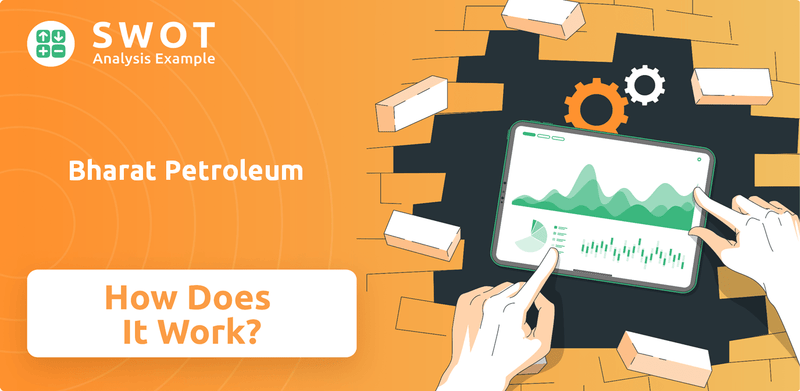
BPCL's operations are critical to India's energy security, managing the pricing of essential products and contributing significantly to the economy. This analysis will explore the Bharat Petroleum SWOT Analysis, delving into its core business model, refining capacity, and market strategies. We'll examine BPCL's financial performance, including its recent impressive results, and how it navigates the challenges of the oil and gas sector, providing insights for investors and industry professionals alike. This exploration will cover various aspects, including BPCL operations, its contribution to the Indian energy market, and its future plans.
What Are the Key Operations Driving Bharat Petroleum’s Success?
The core operations of Bharat Petroleum Company (BPCL) encompass the entire hydrocarbon value chain, from sourcing crude oil to refining and distributing petroleum products. This integrated approach is central to BPCL's business model, ensuring control over quality and supply. As of March 31, 2024, the company's refining capacity stood at 35.3 MMTPA, spread across three major refineries located in Mumbai, Kochi, and Bina.
BPCL's value proposition is built on its extensive network and operational efficiency within the Indian oil industry. The company's widespread distribution network ensures the availability of petroleum products across the country. BPCL's vast infrastructure, including its retail outlets and LPG distributorships, is a key factor in its market presence and ability to serve a large customer base.
BPCL’s strategic initiatives, including infrastructure expansion and investments in green energy, demonstrate its adaptability and commitment to meeting evolving energy demands. The company's focus on expanding its network and exploring sustainable energy solutions highlights its proactive approach in the dynamic oil and gas sector.
BPCL operates three refineries with a combined capacity of 35.3 MMTPA as of March 31, 2024. These refineries are located in Mumbai, Kochi, and Bina. The company's high-capacity utilization rates at its refineries are a testament to its operational efficiency in petroleum refining.
BPCL has a vast distribution network, including over 22,921 retail outlets (as of January 2025) and over 6,200 LPG distributorships. This extensive network ensures widespread availability of its products across India. BPCL serves approximately 9.46 crore domestic LPG connections (FY24).
BPCL's product portfolio includes petrol, diesel, lubricants (under the MAK Lubricants brand), aviation fuel, and natural gas. The company is also expanding its focus on electric vehicle (EV) charging infrastructure. The company is also expanding its focus on electric vehicle (EV) charging infrastructure.
BPCL sources crude oil globally, including a significant portion from Russia. In Q4 FY 2024-25, Russian crude accounted for 24% of its crude throughput. This strategic sourcing helps in managing costs and ensuring a steady supply of crude oil.
BPCL is actively expanding its infrastructure, planning to add approximately 4,000 petrol pumps. It is also developing EV charging facilities at around 7,000 fuel stations over the next five years. This expansion is part of BPCL's strategy to adapt to changing market demands and promote sustainability.
- Focus on expanding retail network and EV charging infrastructure.
- Exploration of green energy and biofuels.
- Commitment to meeting evolving energy demands.
- Adaptability and strategic planning in the Competitors Landscape of Bharat Petroleum.
Bharat Petroleum SWOT Analysis
- Complete SWOT Breakdown
- Fully Customizable
- Editable in Excel & Word
- Professional Formatting
- Investor-Ready Format
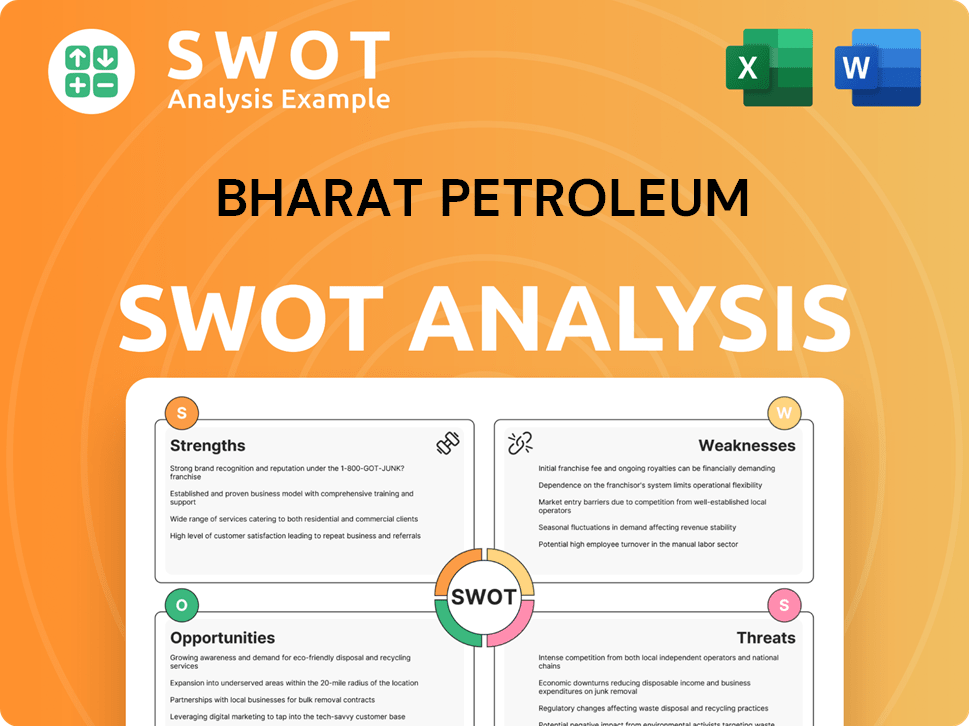
How Does Bharat Petroleum Make Money?
Bharat Petroleum Corporation Limited (BPCL) generates revenue primarily through the refining and marketing of petroleum products. This constitutes the core of its BPCL operations, making it a key player in the Indian oil industry. The company's financial performance is heavily reliant on its ability to efficiently refine crude oil and effectively market its products across India.
The company's revenue streams are diversified, including sales of petrol, diesel, LPG, lubricants, aviation turbine fuel, natural gas, and petrochemicals. BPCL's business model is designed to capitalize on the growing demand for energy in India, while also expanding into new areas such as natural gas and petrochemicals. This strategy aims to ensure sustainable growth and profitability in a competitive market.
BPCL's total income for FY 2024-25 was ₹5,03,457.45 crore, with ₹5,00,371.25 crore derived from operations. This robust financial performance underscores the company's strong position in the oil and gas sector and its ability to navigate market dynamics. Understanding these revenue streams is crucial for any analysis of BPCL's financial health and future prospects.
This is the largest revenue contributor for BPCL. As the second-largest oil marketing company in India, BPCL holds approximately 25.37% market share in FY2024. Market sales reached 52.40 million metric tonnes in FY 2024-25, reflecting a growth of 2.66%.
BPCL has a significant market share of 27.39% in LPG as of FY24. The company has a wide distribution network of over 6,252 distributors. It achieved its highest-ever bottling volume of 7.9 MMT in FY24.
Sales of MAK Lubricants contribute to the company's revenue. This segment adds to the diversification of BPCL's product offerings and revenue streams.
BPCL supplies fuel to both domestic and international airlines. It operates through its 79 aviation service stations. This segment is crucial for supporting air travel.
The company is expanding its footprint in the natural gas sector. This includes city gas distribution (CGD) infrastructure and compressed natural gas (CNG) stations. BPCL finalized its first Liquefied Natural Gas (LNG) sourcing contract linked to the Henry Hub Index with ADNOC Trading, with deliveries slated to begin in calendar year 2025.
BPCL is expanding its petrochemical portfolio. This includes projects at its Bina and Kochi refineries. These projects will contribute to future revenue and diversification.
BPCL's monetization strategies involve optimizing gross refining margins (GRM), which are influenced by global crude oil prices and crack spreads. The average GRM for BPCL dropped to $6.82 per barrel in FY 2024-25, significantly lower than $14.14 per barrel in FY 2023-24. However, marketing margins on auto fuels have remained healthy, supporting profitability. For more insights, explore the Marketing Strategy of Bharat Petroleum.
- Strategic partnerships and joint ventures are also key.
- The agreement with Sembcorp Green Hydrogen India Private Limited explores renewable energy and green hydrogen projects.
- These initiatives diversify future revenue potential.
- Focus on sustainable practices and expansion into new energy sources.
Bharat Petroleum PESTLE Analysis
- Covers All 6 PESTLE Categories
- No Research Needed – Save Hours of Work
- Built by Experts, Trusted by Consultants
- Instant Download, Ready to Use
- 100% Editable, Fully Customizable
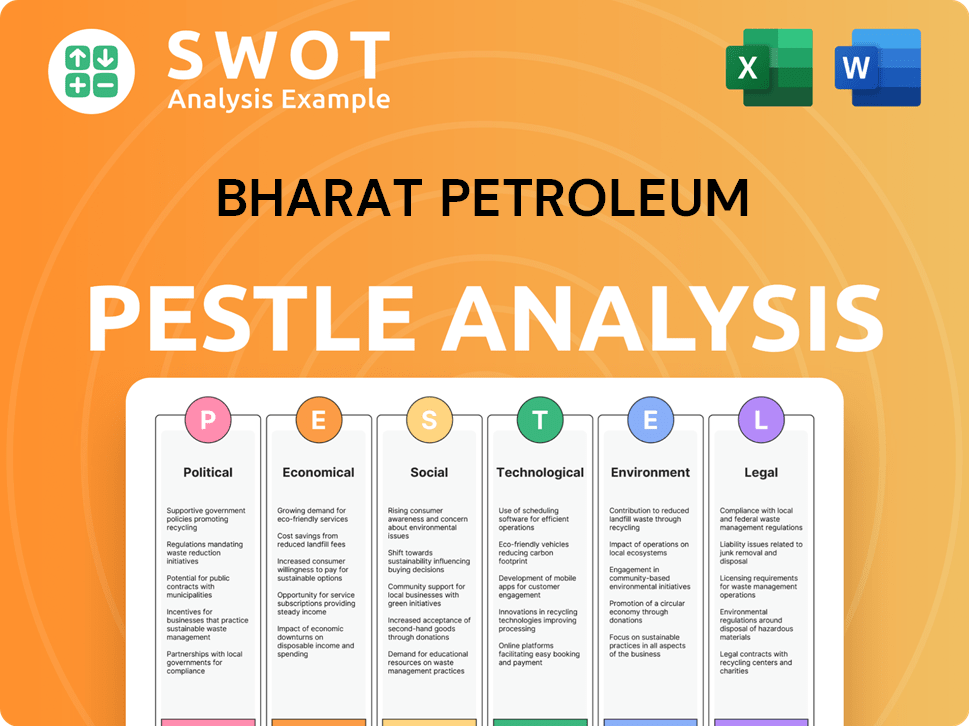
Which Strategic Decisions Have Shaped Bharat Petroleum’s Business Model?
The evolution of Bharat Petroleum Company (BPCL) has been marked by significant milestones and strategic shifts, shaping its operations within the Indian oil industry. These moves have been crucial in navigating the complexities of the petroleum refining and oil and gas sector. The company's strategic decisions and competitive positioning are vital to understanding its role in the Indian energy market.
A key strategic move has been the aggressive capital expenditure plan. BPCL has allocated ₹16,400 crore for FY 2025, increasing to ₹20,000 crore for FY 2026, and projected to reach ₹25,000 crore in FY 2026-27 and ₹30,000 crore subsequently. This substantial investment, totaling ₹1.7 trillion over five years, is primarily aimed at expanding refining and petrochemical capacities, enhancing marketing infrastructure, and venturing into green energy. These investments are pivotal for BPCL's future growth and its ability to meet the rising energy demands in India.
BPCL's operations are influenced by various factors, including the volatility of crude oil prices, which can impact refining margins, and regulatory risks related to the pricing of sensitive petroleum products. The company's profitability in 9M FY2025 was affected by subdued refining margins, under-recovery on domestic LPG sales, and inventory loss on crude oil due to falling prices. However, BPCL has responded by leveraging its established market position and optimizing its crude procurement, including sourcing discounted Russian crude.
BPCL has achieved several significant milestones, expanding its refining capacity and market reach. The company's history reflects a consistent effort to modernize its operations and adapt to changing market dynamics. These achievements are crucial for understanding BPCL's growth trajectory and its impact on the Indian economy.
BPCL's strategic moves include substantial investments in infrastructure and technology. These investments are designed to enhance refining capabilities and expand its distribution network. The company's focus on renewable energy projects, with a target of 10 GW by 2040, demonstrates its commitment to sustainability and future-proofing its business model.
BPCL's competitive advantages include its significant sovereign ownership (52.98% by the Government of India), providing financial flexibility and strategic importance. Its well-known brand and extensive marketing network, with over 23,500 fuel stations as of May 2025, strengthen its market presence. The company's diversified refinery locations also offer logistical advantages.
BPCL is investing in renewable energy projects and aiming for net-zero emissions by 2040 in Scope 1 and Scope 2 emissions. Recent strategic partnerships, such as the joint venture with Sembcorp for green hydrogen and renewable energy, demonstrate its commitment to a sustainable future. These initiatives are crucial for long-term growth and environmental responsibility.
BPCL's strengths lie in its robust infrastructure, extensive distribution network, and strategic investments. The company's ability to adapt to market changes and regulatory environments is also a key factor in its success. For a deeper dive into the company's growth strategy, consider reading more about the Growth Strategy of Bharat Petroleum.
- Financial Flexibility: Backed by significant government ownership.
- Extensive Network: Over 23,500 fuel stations as of May 2025.
- Strategic Investments: Focused on refining, petrochemicals, and green energy.
- Sustainability Focus: Aiming for net-zero emissions by 2040.
Bharat Petroleum Business Model Canvas
- Complete 9-Block Business Model Canvas
- Effortlessly Communicate Your Business Strategy
- Investor-Ready BMC Format
- 100% Editable and Customizable
- Clear and Structured Layout
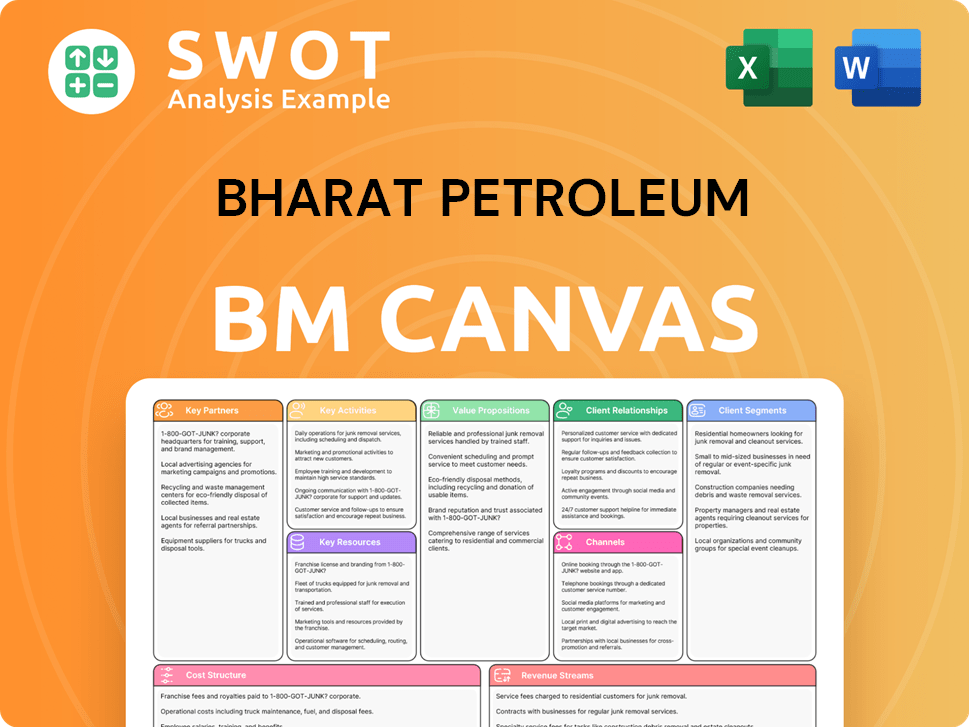
How Is Bharat Petroleum Positioning Itself for Continued Success?
Analyzing the industry position, risks, and future outlook of Bharat Petroleum Company (BPCL) is crucial for understanding its operations and potential. As one of India's leading Oil Marketing Companies (OMCs), BPCL plays a significant role in the Indian oil industry. Its business model and strategic initiatives are key to its long-term sustainability and contribution to the Indian energy market.
Understanding BPCL's position within the oil and gas sector and its future plans is essential for investors and stakeholders. This analysis delves into BPCL's market share, the challenges it faces, and its strategic direction, providing a comprehensive view of its operations and potential.
BPCL holds a strong position in the Indian oil industry. In FY2024, it had a market share of approximately 25.37% in the domestic oil marketing business. It is the third-largest refiner, with about 14% of India's total refining capacity.
BPCL faces several risks, including vulnerability to global refining margins and crude oil price fluctuations. Regulatory risks and project execution risks, such as those related to the Bina refinery expansion, also pose challenges. Global economic uncertainties and competition in the renewable energy sector are additional headwinds.
BPCL has ambitious plans for capacity expansion and diversification into green energy. The company aims to expand its refining capacity to 45 MMTPA by FY29 and is exploring a new greenfield refinery project. BPCL is targeting 10 GW of renewable energy capacity by 2040 and aims to be a Net Zero Energy Company by 2040 for Scope 1 and Scope 2 emissions.
Strategic initiatives include investments in biofuels, solar energy, EV charging infrastructure, and green hydrogen and biogas projects through joint ventures. These moves are designed to sustain revenue generation and maintain leadership in the evolving energy landscape. Further insights into the target market can be found in this article: Target Market of Bharat Petroleum.
BPCL's future depends on its ability to manage risks and successfully execute its strategic plans. The company's focus on renewable energy and capacity expansion are critical for long-term growth. Understanding BPCL's refining capacity details and how it handles crude oil procurement is vital for assessing its performance.
- Market share and refining capacity are key indicators of BPCL's industry position.
- Risks include price volatility, regulatory changes, and project execution challenges.
- Future plans involve capacity expansion and diversification into renewable energy sources.
- Strategic initiatives include investments in biofuels, solar, and EV infrastructure.
Bharat Petroleum Porter's Five Forces Analysis
- Covers All 5 Competitive Forces in Detail
- Structured for Consultants, Students, and Founders
- 100% Editable in Microsoft Word & Excel
- Instant Digital Download – Use Immediately
- Compatible with Mac & PC – Fully Unlocked
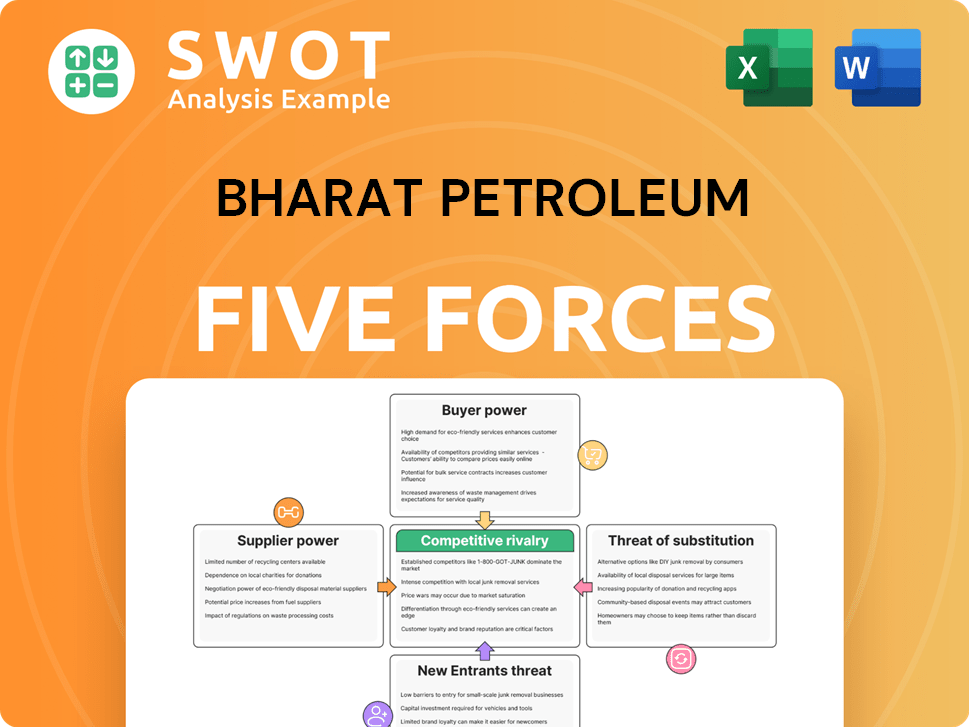
Related Blogs
- What are Mission Vision & Core Values of Bharat Petroleum Company?
- What is Competitive Landscape of Bharat Petroleum Company?
- What is Growth Strategy and Future Prospects of Bharat Petroleum Company?
- What is Sales and Marketing Strategy of Bharat Petroleum Company?
- What is Brief History of Bharat Petroleum Company?
- Who Owns Bharat Petroleum Company?
- What is Customer Demographics and Target Market of Bharat Petroleum Company?
Disclaimer
All information, articles, and product details provided on this website are for general informational and educational purposes only. We do not claim any ownership over, nor do we intend to infringe upon, any trademarks, copyrights, logos, brand names, or other intellectual property mentioned or depicted on this site. Such intellectual property remains the property of its respective owners, and any references here are made solely for identification or informational purposes, without implying any affiliation, endorsement, or partnership.
We make no representations or warranties, express or implied, regarding the accuracy, completeness, or suitability of any content or products presented. Nothing on this website should be construed as legal, tax, investment, financial, medical, or other professional advice. In addition, no part of this site—including articles or product references—constitutes a solicitation, recommendation, endorsement, advertisement, or offer to buy or sell any securities, franchises, or other financial instruments, particularly in jurisdictions where such activity would be unlawful.
All content is of a general nature and may not address the specific circumstances of any individual or entity. It is not a substitute for professional advice or services. Any actions you take based on the information provided here are strictly at your own risk. You accept full responsibility for any decisions or outcomes arising from your use of this website and agree to release us from any liability in connection with your use of, or reliance upon, the content or products found herein.